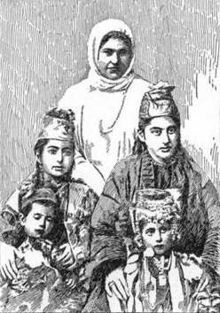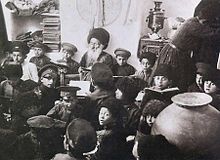Mountain Jews

As Mountain Jews ( Russian Горские евреи , Gorskije jewrei "Mountain Jews") refers to the indigenous Jewish population in Dagestan and North Azerbaijan , in smaller numbers in Kabardino-Balkaria , Chechnya , the Stavropol region and in Karachay-Cherkessia and the Krasnodar region . In Israel, mountain Jews are called Kavkasim ("Caucasians") (sometimes together with Georgian Jews ); Azerbaijanis call them Dağ yahudiləri (a combination of the words dağ , derived from the Azerbaijani word for “mountain”, and yahudi “Jew”).
Most of the mountain Jews (over 50,000) live in Israel today according to the alias . The Russian census in 2002 found only 3394 mountain Jews who are citizens of Russia .
The mountain Jews speak an Iranian language (called Juvuri or Juhuri ), which is very close to the Tatar and Persian languages. They refer to themselves as Juhuro ( Juvuro in the Quba dialect), which translates as 'Jews'. An alternative self-designation is deed . The Jewish religion and customs have been maintained and cultivated for centuries.
Origin and history
The ancestors of the mountain Jews came from ancient Persia, probably from Atropatene , which had a large Jewish minority in pre-Islamic times, from Fars and probably earlier from Iraq. The first settlements and the oldest synagogues were found in Derbent in Dagestan, and they continued to settle in the Quba region , in the Tabassaranen region and at the eastern end of the Caucasus . They also lived in the Shirvan region north of the Kura until the 20th century .
To this day it is not clear when Jewish and non-Jewish “deeds” immigrated to Albania or Arrān . Presumably it was a pre-Islamic settlement around 510. Al-Balādhurī reported that Chosrau I , who built the " Hun wall " around Derbent into a fortification of 400 km in length against northern steppe peoples, had settled more loyal Zoroastrian and Jewish populations at the fortifications . The Derbent local history Darbandname explains more precisely that Chosrau settled people from Atropatene and Fars in Derbent and the surrounding area, while further south people from Fars and Iraq. A minority opinion of historical research sees the ascription of the settlement on Chosrau I as a legend and hypothesized that most of the deeds and mountain Jews only fled to the region in the early Islamic period. This minority opinion is not recognized by most researchers. While the settlement in the region has already been largely recognized by pre-Islamic Sassanids, there are still debates whether the attribution to Chosrau I, the “just king Kisra” of the legend, is historically correct, or whether it was already attributed to Yazdegerd II , Kavadh I. or only Chosrau II. Goes back.
Mountain Jews were placed under protection by the Khazarian Kagan , who had previously converted to Judaism , during his temporary rule in the region. There are Zoroastrian holdovers in the customs of Gentile deeds .
In contrast to most of the regional Jewish groups ( Ashkenazim , Sephardim , Bucharian Jews , etc.) who, due to their social minority position, partly also through migration or restrictions on land ownership, have lived mostly in small towns or districts from handicrafts, services or trade since the Middle Ages , Mountain Jews (such as Kurdish Jews ) were a village population who lived primarily from agriculture. The traditions of Muslim and Jewish “deeds” were also similar to those of neighboring mountain peoples who were able to defend themselves. That only changed with the general modernization and urbanization that began in the 19th century. Since this time of common affiliation to Russia, there have also been religious and cultural contacts with Eastern European Jews. As the introduction of Mikwaot or klezmer similar clarinet music in addition to continuing manicured Caucasian dance music ( Lezghinka was u. A.).
holocaust
As in World War II German troops to the northern end of 1942 Caucasus occupied and there a few thousand Mountain Jews vorfanden, there was under Nazi -Autoritäten (including Theodor Oberlander ) discussions on the question of whether these them hitherto little-known minority of commitment or even after racial criteria as was to be classified as Jewish. Several hundred mountain Jews were murdered before the Germans withdrew in 1943. On August 19 and September 20, 1942, 850 mountain Jews were murdered near Mozdok (Kolkhoz Bogdanovka and Menžinskoe ); Another 1,000 fell into the hands of the Germans in Nalchik in October 1942 , who were forced to wear the Jewish star and to do forced labor . The majority, however, were spared the scheduled destruction . However, most of the mountain Jews lived in South Dagestan and North Azerbaijan, regions that the Wehrmacht had not reached.
Development after 1990
In the early 1990s were some of the town Qırmızı Qəsəbə (Russian: Krasnaya Sloboda , "Red Settlement") grown Mountain Jews as Telman Ismailov , Sarach Ilijew or God Nisanow on newly created Moscow markets, such as the cherkizovsky market , active and were rich through their businesses over the years. Today they dominate part of Moscow's shopping centers and own real estate in Moscow, for example the Hotel Ukraina, built in the Stalinist confectioner style . A connection to their homeland persists, which is evident in the quality of the streets, the Jewish cemeteries , the new Bet Knesset synagogue and the exterior of the houses in Qirmizi Qesebe.
The fifth largest mountain Jewish community in the world lives in Germany. In 2014, the Bergjuden in Deutschland eV community was founded in Frankfurt am Main .
See also
literature
- Kiril Feferman: Nazi Germany and the Mountain Jews. What is there a policy? In: Holocaust Genocide Studies , Vol. 21 (2007), pp. 96-114, ISSN 8756-6583 .
Web links
- Russian report in English about the community in Nalchik
Individual evidence
- ↑ Asif Masimov: JUDAISM IN AZERBAIJAN: JERUSALEM THE CAUCASUS. In: masimovasif.net. October 8, 2019, accessed January 6, 2019 .
- ↑ Cf. article “Tat” in the Encyclopedia of Islam, first edition, Leiden 1903–1936 by Vladimir Minorsky - their old tradition of orienting the synagogues to the west instead of Jerusalem speaks for a previously far more southern origin, including their pronunciation of the Tat speaks for a former settlement area in the Arabic-speaking area and cannot be explained by Aramaic or Hebrew language influences
- ↑ Baladhuri, p. 194
- ↑ Emanuel Sarkisyanz : History of the Oriental Peoples of Russia until 1917. Munich 1961, p. 144
- ↑ Darband-nama. Print edition v. Aleksandr K. Kazembek (French), St. Petersburg 1851, p. 461
- ↑ This thesis was first represented by Heinrich Julius Klaproth, who argued that those settled by Chosrau I were rather tabassarans and Christian Armenians and Udines .
- ↑ Kiril Feferman: “ Nazi Germany and the Mountain Jews: Was There a Policy? ", In: Richard D. Breitman (Ed.): Holocaust and Genocide Studies Volume 21 Spring 2007, Oxford University Press , pages 96-114.
- ↑ Market economy at the beginning. In: FAZ of April 11, 2011, page 16.
- ^ Congregation of the mountain Jews in Germany
